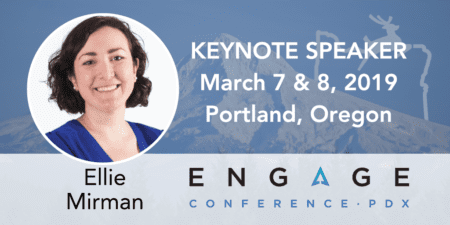 Ellie Mirman will be giving a keynote at Engage which will take place March 7–8 in Portland Oregon. For more information or to purchase tickets, please click here.
Ellie Mirman will be giving a keynote at Engage which will take place March 7–8 in Portland Oregon. For more information or to purchase tickets, please click here.
1) Please give us your background and let us know what you do for a living.
I’m the Chief Marketing Officer at Crayon, a market and competitive intelligence company. Previously, I was the VP Marketing at Toast, a restaurant tech company, and led the inbound lead generation team at HubSpot.
2) When do businesses typically decide they need a Competitive Intelligence Tool?
Businesses often invest in competitive intelligence when they’ve lost to a competitor in some way – lost sales deals, had a marketing campaign fall flat, been left out of a marketing activity or sales opportunity, been surpassed by a competitor’s product, or been blindsided by a competitor. In other words, they wait until it’s too late to beat a competitor, and then try to make sure that never happens again. Competitive intelligence tools and programs allow businesses to get and stay ahead, something every business wants to do but doesn’t necessarily have the practices built to do so yet.
3) If someone were to tell you that they can do effective Competitive Intelligence via manual Google Searches, how would you respond?
Google searches can uncover a competitor’s announcements, but that’s only the tip of the iceberg when it comes to competitive intelligence. Would a competitor announce that their customers are unhappy? No, but you can find that in customer reviews online. Would a competitor announce that they’ve changed their messaging to focus on a different buyer? No, but careful tracking of their website copy will uncover that. Would a competitor tell you where they’re investing in product development? No, but analysis of their hiring activity and customer documentation can reveal that. On top of that, relying on Google searches is an easy way to get overwhelmed with the amount of updates instead of leveraging technology to capture the data and surface insights that are much more actionable.
4) As a Paid Search expert, I see tremendous value in analyzing Paid Search data for Competitive Intelligence purposes. What are your thoughts on this?
Analyzing a competitor’s paid search activities can be a great way to understand their target markets, marketing focus areas, and conversion best practices learned through trial and error.
5) I’ve read Avinash Kaushik for many years and he always focuses on making data actionable to the C-level. How can a marketer use their Crayon data in an optimum fashion when reporting up the corporate chain?
Here are a few suggestions:
1. Share key competitive intelligence in real-time: When a competitor makes a big move (acquisition, public offering, new chief executive, major product launch), alert the C-suite in real-time. This allows the leadership to discuss and act as quickly as possible, instead of waiting until the market has shifted and left your company behind.
2. Focus on the ‘so what’: Add a layer of analysis with any insight shared – it’s not just what happened, but why and how it will impact the business, and the decisions you now face. This will take the business from being paralyzed by competitor moves to being agile and truly competitive.
3. Consider the company’s priorities: What open questions does the C-suite have? What initiatives are on their mind? Focus on intelligence that answers those questions or provides evidence related to a company priority. This will help make the intelligence relevant and actionable.
Go to Ellie’s Keynote on the Agenda
Todd Mintz knows PPC…knows Social Media…knows SEO…knows Blogging…knows Domaining…and knows them all real well. He runs growth marketing for )and is also a Director & Founding Member of SEMpdx: Portland, Oregon’s Search Engine Marketing Association, and he can be found here on Twitter and Facebook.
